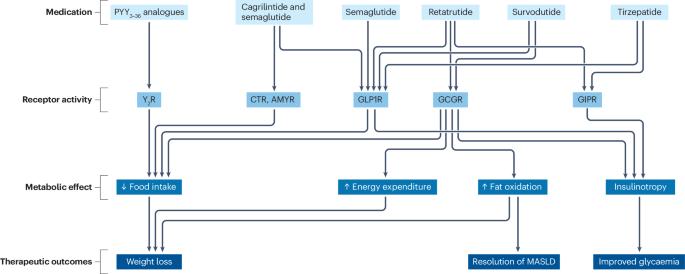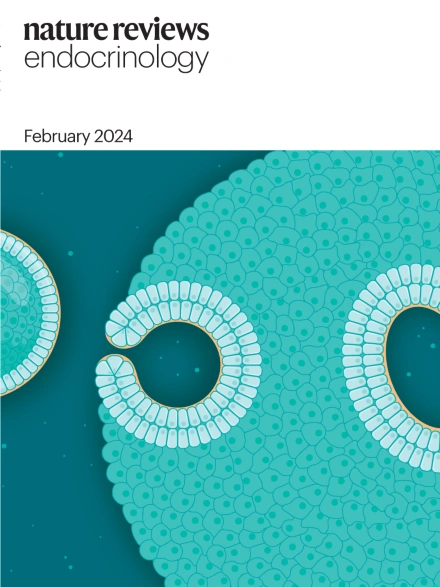针对肥胖症和 2 型糖尿病的增量素系统
IF 40
1区 医学
Q1 ENDOCRINOLOGY & METABOLISM
引用次数: 0
摘要
肥胖症和 2 型糖尿病(T2DM)是普遍存在的非传染性疾病,在全球范围内造成了相当高的发病率和死亡率,主要表现为心血管疾病(CVD)。改变生活方式和行为对大多数此类疾病患者的长期疗效不佳;代谢外科手术虽然有效,但实际上无法达到所需的规模。过去二十年来,以胰高血糖素样肽 1(GLP1)受体激动剂(GLP1RAs)为首的增量素激素疗法已成为治疗肥胖症和 T2DM 的首选疗法,现在的临床证据表明,这些药物对心血管疾病也有益处。我们回顾了增量素药物疗法的最新进展。其中包括 "GLP1 plus "药物,这种药物将 GLP1RAs 的已知优势与葡萄糖依赖性胰岛素促肽、胰高血糖素和淀粉样蛋白等其他激素的活性相结合,以达到预期的治疗目标。第二代非肽类口服 GLP1RA 有望将 GLP1 疗法的益处扩大到那些不想或不能接受皮下注射疗法的患者。最后,我们讨论了在适当使用增量素疗法治疗肥胖症和 T2DM 以取得最大疗效之前必须解决的知识空白问题。本文章由计算机程序翻译,如有差异,请以英文原文为准。


Targeting the incretin system in obesity and type 2 diabetes mellitus
Obesity and type 2 diabetes mellitus (T2DM) are widespread, non-communicable diseases that are responsible for considerable levels of morbidity and mortality globally, primarily in the form of cardiovascular disease (CVD). Changes to lifestyle and behaviour have insufficient long-term efficacy in most patients with these diseases; metabolic surgery, although effective, is not practically deliverable on the scale that is required. Over the past two decades, therapies based on incretin hormones, spearheaded by glucagon-like peptide 1 (GLP1) receptor agonists (GLP1RAs), have become the treatment of choice for obesity and T2DM, and clinical evidence now suggests that these agents have benefits for CVD. We review the latest advances in incretin-based pharmacotherapy. These include ‘GLP1 plus’ agents, which combine the known advantages of GLP1RAs with the activity of additional hormones, such as glucose-dependent insulinotropic peptide, glucagon and amylin, to achieve desired therapeutic goals. Second-generation non-peptidic oral GLP1RAs promise to extend the benefits of GLP1 therapy to those who do not want, or cannot have, subcutaneous injection therapy. We conclude with a discussion of the knowledge gaps that must be addressed before incretin-based therapies can be properly deployed for maximum benefit in the treatment of obesity and T2DM. This article reviews advances in incretin-based pharmacotherapy, including the latest glucagon-like peptide 1 (GLP1) receptor agonists (GLP1RAs), ‘GLP1 plus’ agents, which combine the benefits of these agonists with the activity of additional hormones, and oral GLP1RAs, which promise to extend the benefits of GLP1 therapy.
求助全文
通过发布文献求助,成功后即可免费获取论文全文。
去求助
来源期刊

Nature Reviews Endocrinology
医学-内分泌学与代谢
CiteScore
42.00
自引率
0.70%
发文量
158
审稿时长
6-12 weeks
期刊介绍:
Nature Reviews Endocrinology aspires to be the foremost platform for reviews and commentaries catering to the scientific communities it serves. The journal aims to publish articles characterized by authority, accessibility, and clarity, enhanced with easily understandable figures, tables, and other visual aids. The goal is to offer an unparalleled service to authors, referees, and readers, striving to maximize the usefulness and impact of each article. Nature Reviews Endocrinology publishes Research Highlights, Comments, News & Views, Reviews, Consensus Statements, and Perspectives relevant to researchers and clinicians in the fields of endocrinology and metabolism. Its broad scope ensures that the work it publishes reaches the widest possible audience.
 求助内容:
求助内容: 应助结果提醒方式:
应助结果提醒方式:


